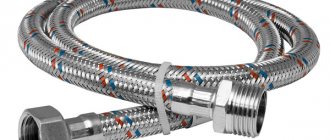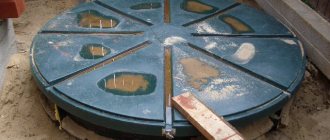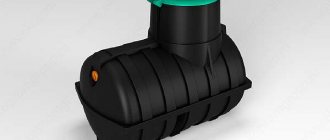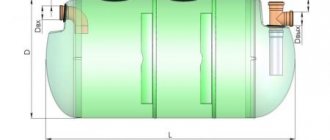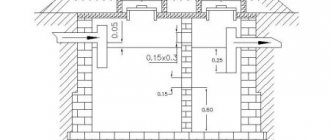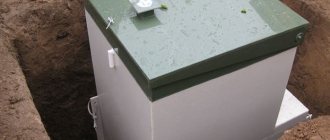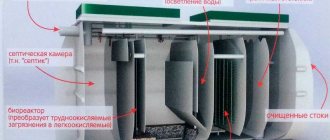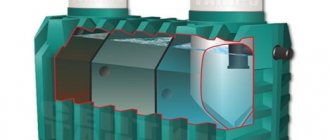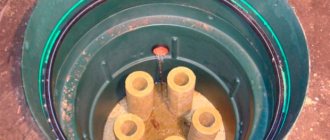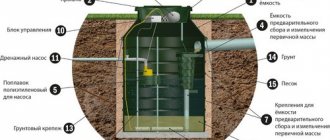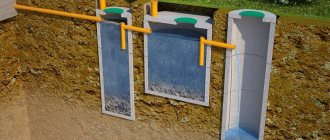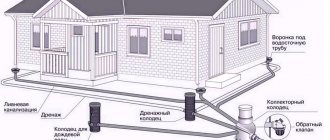Many people believe that installing a local sewer system is very expensive and difficult, so they do not want to improve their dachas, which are used for periodic recreation. Meanwhile, using a mini-septic tank you can solve the problem of wastewater recycling at low cost. It is quite possible to install such a miniature septic tank yourself, this will save significant money on paying for the services of installers.
Even if the dacha is not used for permanent residence, it is worth improving it. After all, even on weekends it’s not very pleasant to use the toilet on the street and wash in a basin. Today you can buy inexpensive mini-septic tanks for your dacha.
These are simple installations that use the settling principle. For final purification, septic tanks are mounted complete with infiltrators or filtration platforms are installed at the outlet.
The most budget option
Many summer residents have a bathhouse and an outdoor shower on their property, so sewerage is required only for servicing the kitchen and toilet; if no more than two people live in the house, a Microbe 450 septic tank is quite suitable (it is one of the cheapest - within 10 thousand . rub.), designed for 450 liters, productivity 150 liters, and weight – 45 kg. This is the so-called weekend septic tank.
And this is how we can talk about each of them - in some respects the performance of one model is better, in others a little worse, but all deviations are within the standards.
Dimensions of mini-septic tanks
The size of the mini-septic tank depends on two factors:
- productivity;
- operating principle.
Anaerobic treatment plants are smaller in size than aerobic ones, since the design of the latter includes an air enrichment system (drainage pump or compressor). Additional volume is required to accommodate it.
In accordance with the intensity of sewer use, mini-septic tanks are divided into:
- universal: models with a capacity of up to 0.5 m3 per day. This volume is enough to serve a small family living in the country permanently;
- for a weekend: their volume is calculated at 0.12 – 0.15 m3/day. A septic tank of this design is considered the most optimal for summer residents who visit their properties only on holidays or weekends.
Mini septic tank
Mini-septic tanks are also available for toilets: their capacity does not exceed 120 liters per day, but they differ from other models in their lightness and miniature size. Such structures can be installed anywhere and without much labor.
In addition to volume, the choice of a specific mini-septic tank model is influenced by its geometric parameters:
- height – working chambers and full (with inspection head);
- length;
- width.
Knowing the above parameters, you can select a plot of land for installing a septic tank. You just need to take into account that the hole will have to be dug 150-200 mm more along the contour of the cross-section of the structure.
What should you pay attention to?
When choosing a septic tank for a summer cottage, you need to take into account several factors: volume, productivity, number of chambers, tightness and strength. Properly selected volume and capacity ensure efficient operation of the system. mini septic tanks, as a rule, are single-chamber, but in this segment you can also find models with two cleaning chambers, although for small volumes of wastewater a single-chamber septic tank is quite sufficient, and it will cost less.
According to the standards (SNiP 2.04.03-85), single-chamber septic tanks are allowed to be used with an equivalent number of inhabitants of up to 5, two-chamber septic tanks - up to 50, and three-chamber septic tanks are used when they serve from 50 to 100 people.
Popular models
Among the considerable list of mini-septic tanks produced by industry, several models are in greatest demand.
Triton mini
The model is designed for constant use of sewerage by two or three residents. Made from low density polyethylene. The body is divided into two chambers. The operating principle is based on biomechanical wastewater treatment. The liquid released into the aeration field is 65% free of contaminants. There the final filtration of wastewater takes place up to 98% - the regulatory safety level.
The declared power of the Triton mini is 400 l/day. In practice, the optimal performance to avoid rapid siltation of the infiltrator does not exceed 250 l/day. This is quite enough to serve two or more people with reasonable water savings.
Model Triton mini
The volume of the septic tank is 750 liters. Its weight together with the infiltrator is 82 kg - therefore, its transportation is not difficult.
Dimensions:
- tank – 1250 x 820 x 1700 mm;
- infiltrator – 1800 x 800 x 400 mm.
The second chamber of the septic tank contains a filter with a floating bioload. Anaerobic microorganisms take part in the cleaning process.
Tank 1
The design of all Tanks is the same - they differ only in performance.
The Tank 1 model is considered a dacha option; its total volume is only one cubic meter.
Inside, the container is divided into three parts using a partition. All three compartments are connected by overflows. The strength of the body is ensured by stiffening ribs.
The first two compartments operate on the principle of a sump, the third plays the role of a biofilter using anaerobic bacteria.
Septic tank dimensions: 1200 x 1000 x 1700 mm, productivity does not exceed 0.6 m3/day. The product weighs 85 kg.
At the customer's request, Tank 1 is equipped with neck attachments that allow you to select the desired installation depth, an additional container and a pump.
Microbe
The mini-septic tank carries out biological treatment of wastewater with the participation of anaerobic bacteria. The wastewater, purified to 85%, is transferred to the infiltrator - a 400-liter container without a bottom.
The Microbes line includes 4 models that differ from each other in volume and performance:
- 450 l – 150 l/day;
- 600 l – 200 l/day;
- 750 l – 250 l/day;
- 900 l – 300 l/day.
The septic tank is made in the form of a round barrel with a diameter of 810 - 1110 mm and a height of 1430 mm. The weight of the smallest model is 35 kg, the largest – 54 kg.
Sprout mini
The two-chamber model is made of multilayer polyethylene. The first is equipped with a special damper that prevents large particles of debris from floating to the top. The second chamber contains two filters – sorption and mesh. A 200 mm layer of zeolite is responsible for adsorption.
The “mini” model in the Rostock family of septic tanks has the lowest productivity - it is only 250 l/day. The total volume of the tank is 1000 liters.
Sprout mini
Overall dimensions of the product:
- length – 1.28 m;
- width – 1.1 m;
- height – 1.7 m.
The mini sprout is lightweight - its weight does not exceed 3 kg. This fact can be considered an advantage during installation, but during operation the septic tank may “float up”.
It is advisable to provide a concrete base for its installation to which the product can be attached.
Strength
Very important for a septic tank is the tightness and strength of the structure. When choosing, special attention should be paid to the quality of the material from which the container is made. Typically, small septic tanks are made from polyethylene or propylene using rotational molding.
Due to additional stiffening ribs, even a mini plastic septic tank with thin walls will be quite strong and resistant to deformation and mechanical damage.
The thickness of the body walls of septic tanks varies from 9 to 25 mm. Of course, the thicker the plastic, the stronger and more reliable it is, but the thicker it is, the more expensive it is. The maximum thickness of the walls of the structure is more relevant for large septic tanks, which have a high risk of contour deformation under the influence of soil (when the tank is empty).
For small containers, soil pressure is also minimal, so the use of thin-walled structures, but reinforced with stiffeners, is not prohibited.
What are the most important technical indicators of a septic tank?
When choosing a mini septic tank for a country house, you need to pay attention to the following indicators:
- Tightness. This criterion is considered the most important. The septic tank must contain all the liquid for the entire period of purification. It is necessary to give preference to models that use plastic or metal material with a thickness of at least 5 mm. As a rule, concrete devices have good integrity, and if problems arise in this case, then mastic or waterproofing must be used.
- Volume. It is necessary to correctly determine the volume based on the amount of water you plan to drain per day. If less than 5 cubic meters per day, then the minimum capacity should be no less than 3 cubic meters.
- Multi-chamber. It is known that a large number of compartments purify water very efficiently, so choosing this model is welcome. Rational consumption in the case of wastewater of 10 or more cubic meters per day.
- Type of bacteria;
- Easy to maintain.
Checking the standards
By the way, about the place. Remember that the installation of even mini septic tanks must be carried out in accordance with the standards:
- the minimum distance from the treatment plant to the house is 5 m and the same should be to the water pipes, if the pipes are cast iron, then 3 m is enough;
- the standard distance from the septic tank to the neighboring area is not less than 2 m;
- the septic tank should be located 30-50 m from the well or well (depending on the throughput of the soil);
- distance to trees – 4 m, to bushes – 1 m, to the river – 10 m, to the reservoir – 50 m.
In the case when underground filtration fields are used for post-treatment of wastewater clarified in a mini septic tank, it must be provided that the sanitary protection zone for them (with a throughput capacity of up to 15 cubic meters per day) is equal to 50 m.
Don't forget about drainage and filtration fields
Masters offer 2 post-treatment systems - drainage or filtration systems.
The drainage (filtration) well is the last chamber in the cleaning system. Often it is a simple well without a bottom. Wastewater treatment is carried out by gradual seepage of water through the ground, so it is important that groundwater is no closer than 2.5 m to the surface. Sand or crushed stone is poured onto the bottom, which becomes a filter pad. The technique is used when groundwater is deep.
This is what a septic tank drainage system looks like when it reaches the ground surface Source tupikov.ru
Important! Several drainage wells are built on clay soils. This is a cheaper option compared to a filtration field.
The filtration field is the pipes through which water passes to be completely purified. They occupy a larger area than a drainage well. With a large amount of water consumed, it can occupy an area of several tens of m². This option is suitable for close groundwater, it is labor-intensive and expensive. Before constructing a field, it is necessary to correctly calculate its dimensions. To install a septic tank for a dacha without electricity, the following are taken into account:
- number of water consumers;
- soil composition;
- diameter of pipes supplying wastewater;
- average annual air temperature.
To enhance the cleaning effect, a layer of sand or crushed stone is poured at the lower level of the field, having previously separated it from the soil with a special filtration fabric.
Installation of the infiltrator
At a distance of 1-2 m from the septic tank, a drainage area is arranged for the infiltrator. This is a plastic product designed for post-treatment of wastewater and is also used in small areas in order to save space for installing a filtration system, because even one such design can replace 36 m of drainage pipe. The infiltrator must accommodate three times the volume of the septic tank, so that during a volley discharge of sewage, untreated waste does not fall into the ground.
To install this device, they also dig a pit, fill its bottom with fine-grained crushed stone, and place the cassette itself on the prepared filtration pad (with a layer of up to 50 cm).
Inlet and outlet pipes are mounted to the infiltrator, through the first of them clarified wastewater flows from the septic tank, and the second serves to ventilate the system and remove gases formed during the decomposition of organic substances. The installed container is covered with soil, and only the ventilation pipe is visible on the surface.
The principle of operation of a septic tank without pumping
Wastewater treatment in such a system occurs due to water settling. The best option is 3 containers into which liquid waste is gradually supplied. The tanks are buried in the ground and connected at the top by a pipe. From each there is an outlet for air intake.
Plastic septic tank made of 3 containers of different volumes Source vse-o-kanalizacii.ru
Domestic wastewater from the house is washed into the first container, and the bulk of the heavy mass settles at the bottom. When the liquid level reaches the pipe connecting the first tank to the second, the water flows into another container. This is a purer substance, but still requires purification. The liquid settles and the masses settle to the bottom. When the water level reaches the connecting pipe, it spontaneously flows into the third tank. This is a vessel with a filtration system at the bottom. Water enters the ground through the filtration purification pad. This is wastewater that has already been treated three times.
There are designs consisting of 2 chambers, but such cleansing is not effective enough.
Filtration well
In order to save money while minimizing wastewater volumes, filtration wells are used instead of an infiltrator. The fact is that the length of the drainage pipes in the filtration field depends on the volume of wastewater. According to the standards, there are 100 liters of wastewater per 1 m of pipe, and 150 liters for gray (clarified) water. Therefore, with a septic tank capacity of 120 liters per day, the length of irrigation pipes is required within 1 m, and even with a wastewater volume of 500 liters, it is enough to lay about 3 m of pipes on the filtration field.
When using universal septic tanks, the most productive in the “mini” category, with a daily discharge of up to 500 liters, according to the law, a filtration well can be used as a post-treatment system - it is much more convenient than a small filtration field.
The drainage well can be laid out of brick without mortar, the bottom of the well is covered with a sand-crushed stone mixture (the thicker the layer, the better the performance), the distance between the walls of the well and the ground within 30 cm is also covered with crushed stone.
A filter well is an additional system for cleaning and filtering liquid from a septic tank that enters it before it is absorbed into the soil. The well must be closed at the top, but it should be possible to open it if necessary.
Advantages of septic tanks without pumping
An important advantage of such a device is the absence of the inherent odor of waste water. Equally important is the significant savings in money - septic tanks for dachas without pumping do not need to be connected to the sewer system, which is an expensive and troublesome task. In addition, many models do not require an electrical connection.
In addition, the entire system is completely buried in the ground and does not pollute the environment, so supervisory authorities do not make claims against such areas.
The drainage pit collects liquid household waste in ordinary soil. In such a situation, the soil around the “storage” becomes saturated with untreated liquid masses, which greatly disturbs the environment. If you add to this a specific smell, the picture turns out to be completely unsightly.
A septic tank is fundamentally different from the old form of waste accumulation. This is an isolated system of containers, hermetically sealed, completely preventing the entry of untreated waste into the soil. Sealing the chambers provides odor protection. The presence of a septic tank on the site can be guessed by the ventilation pipes.
An important advantage of a septic tank without pumping is complete sealing Source proagregat.com
Price list for installation of septic tank Microbe
| Model | Dimensions (LxH), mm | Volume, l | Productivity, l/day. | Weight, kg | price, rub. | Installation, rub. |
| Microbe 450 | 810x1430 | 450 | 150 | 35 | 9600 | 8350 |
| Microbe 600 | 910x1430 | 600 | 200 | 42 | 11600 | 10450 |
| Microbe 750 | 1010x1430 | 750 | 250 | 48 | 13500 | 12250 |
| Microbe 900 | 1110x1430 | 900 | 300 | 54 | 15000 | 14050 |
| Infiltrator | 1800x800x400 | — | — | 15 | 4500 | 8850 |
What should you consider when choosing a mini model?
On store shelves and the Internet you can find thousands of models that will turn your head and confuse your choice. We recommend that you always start from two indicators:
- The number of people who live in the house;
- Intensity of use of this system.
For example, if you take a family that consists of 2-3 people, then a mini septic tank is ideal for you.
Purchase price and operating cost
So, we come to the most pressing issue - price. Sewerage installation requires significant investment, and the desire to save money by choosing a cheaper model with the same performance is understandable.
Pump + ejector Patent No. 166595
Eurolos Bio
Local wastewater treatment plant
68,500
rubles
Station price
Description
Autonomous pumping station for the treatment of domestic wastewater for a suburban area with seasonal or permanent residence.
Main characteristics
- Does not require wastewater treatment
- Family of 2 people
- 1 bathroom, 2 taps and shower
Recommendations
After installing a septic tank, it is prohibited:
- Go deep into the ground to a depth of more than 1 m from the top edge of the product to the ground level;
- Use of construction equipment when backfilling a container;
- Compacting soil using construction equipment;
- Causing any mechanical damage;
- Passage of vehicles over an operating septic tank. If traffic is expected, it is necessary to pour a reinforced concrete platform 25 cm thick on top of the septic tank;
- Planting trees closer than 3 meters from the location of the septic tank or storage tank;
- Installation of a filter platform at a distance of less than 15 meters from wells and boreholes.
Description and purpose
Attention! Super discounts on products up to 50% Discounts on installation up to 30% FREE storage! Advance payment for the promotion with storage of only 50%
Don't wait for prices to go up, buy now at the lowest price.
The maximum possible discounts are currently in effect.
Book a date that is convenient for you for shipment and installation while the queue is forming and there is such an opportunity.
NO ONE HAS SUCH PRICES!!! HURRY!!!
CALL:
Moscow
| Russia |
Order
Order a specialist visit
HURRY! Prices valid ONLY until February 6th
Installation and maintenance
These are also important parameters for choosing a septic tank for a summer residence. Despite the fact that, in general, you can install a plastic septic tank on your own, it is still better to entrust this work to specialists and use the manufacturer’s service: Turnkey installation of a septic tank. Installation errors can lead to problems with operation, dismantling, and complex and expensive reconstruction of the sewer system. It's not worth taking that risk.
Features of the installation of septic tanks depend on various factors, but first of all, these are the hydrogeological conditions on the site:
- Luck can be installed in areas with well-draining soils.
- Eurolos Eco is a very good choice for sandy soils, but such models are absolutely not suitable for use as flow-through septic tanks for a dacha with a high groundwater level.
- Eurolos Bio and Pro have virtually no restrictions on installation due to hydrological conditions. They can even be mounted in quicksand.
Almost all septic tanks require maintenance. No matter how paradoxical it may seem, the simplest storage septic tanks are the most labor-intensive to maintain. In fact, this is an improved version of a cesspool and requires constant pumping with a sewer truck. Do you want to do without sewer trucks with all the accompanying delights in the form of fetid miasma spreading throughout the site? Choose a septic tank without pumping.
- Flow septic tanks are energy independent and require virtually no human intervention during their service life. The downside is silting of drainage elements and filtration fields, which requires periodic washing or refurbishment.
- Although VOCs are equipped with volatile equipment, they are very simple to maintain. The Bio model requires only regular loading of biological products. Pro stations do not even require such intervention.
The energy dependence of local stations is not their disadvantage, especially in houses with permanent residence. Even in the event of a power outage, you will not be left without a working sewer system. The septic tank will work like a regular flow model. Once the power supply is restored, operation is fully restored.
